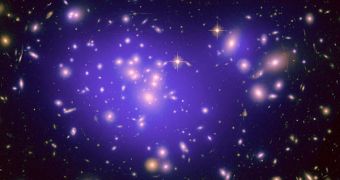A team of astronomers believes it may have established the location of massive dark matter clouds inside Abell 1689, an extremely large galaxy cluster. The formation has a gravitational pull whose strength cannot be accounted for by the existing, visible matter.
Therefore, investigators say that large clouds of dark matter may also exist within the huge structure. This type of matter interacts with normal (baryonic) matter solely through gravitational effect.
In fact, the entire concept of dark matter was developed so that experts could explain why galaxies and clusters have a much more intense gravitational pull than the mass they contain could theoretically produce. Still, no research team has ever been able to find traces that dark matter actually exists.
In the new study, experts from the Space Telescope Science Institute (STScI), in Baltimore, Maryland, led by astronomer Dan Coe, argue that they managed to identify the areas of Abell 1689 where massive dark matter clouds are located.
This cluster is enormous, containing literally trillions of stars, and well over 1,000 galaxies, Daily Galaxy reports. Such a tremendous size and spread is making the cluster act like an enormous lens in space, which gave Coe and his group the opportunity to study how light is bent.
Gravity has the tendency to distort light in the same way that a pool of water changes the paths of photons traveling through it. By studying the subtleties of these distortions, experts can gain more insight into the nature and distribution of the forces acting to change the path light usually takes.
Mapping the location of dark matter clouds – in the center of Abell 1689 – is a tremendous achievement, but means little if the stuff is not proven to actually exist. While its presence would solve numerous astronomical mysteries, scientists cannot find the particles making it up.
“They’re very elusive. Astronomers hope [dark matter particles] will be discovered in the next decade,” says Observatories of the Carnegie Institution (OCI) director Wendy Freedman.
She explains that finding these particles has thus far been a process of elimination, in which some experts proposed that a class of particles formed dark matter, while other scientists proved that that was not the case.
But the range of particles from which the stuff could be theoretically made of is getting narrower every year, and experts still see no signs of dark matter.
Not finding the stuff would have great implications for astronomy and astrophysics, and would send scientists back to square one in explaining the Universe.

 14 DAY TRIAL //
14 DAY TRIAL //